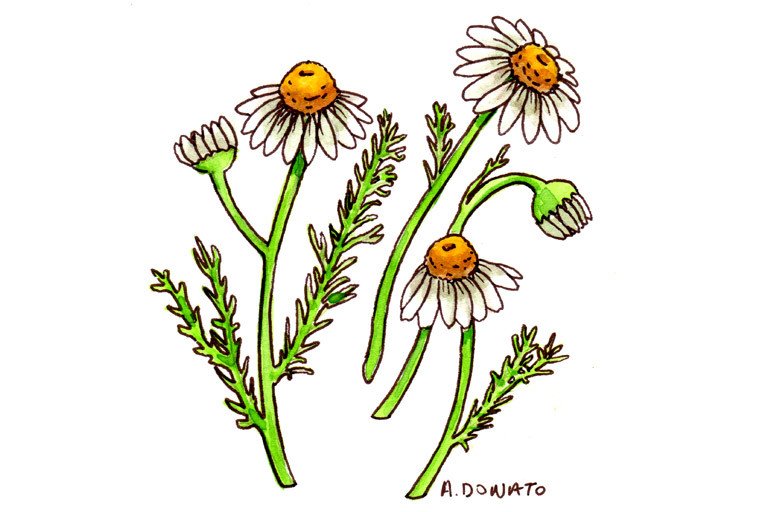
Common Names
- German chamomile
- Hungarian chamomile
- Wild chamomile
- Scented mayweed
For Patients & Caregivers
Tell your healthcare providers about any dietary supplements you’re taking, such as herbs, vitamins, minerals, and natural or home remedies. This will help them manage your care and keep you safe.
Chamomile is an herb used in traditional medicine for its relaxing and calming effects. It’s mostly taken as herbal tea. You can also take chamomile capsules or tablets.
Chamomile is used to:
- Lower stress
- Treat insomnia (trouble falling asleep, staying asleep, or waking up too early)
- Lower anxiety (strong feelings of worry or fear)
- Treat depression
- Treat mouth sores from cancer treatment
- Treat upset stomach and diarrhea ((loose or watery bowel movements)
Chamomile also has other uses that haven’t been studied by doctors to see if they work.
It’s generally safe to take chamomile in the form of tea, but talk with your healthcare providers before taking chamomile supplements. Herbal supplements are stronger than the herbs you would use in cooking. They can also interact with some medications and affect how they work. For more information, read the “What else do I need to know?” section below.
You are more likely to have allergic reactions to chamomile if you’re allergic to plants related to chamomile such as ragweed, chrysanthemums, marigolds, or daisies. Allergic reactions can include:
- Asthma (respiratory condition which makes it difficult to breathe)
- Contact dermatitis (red, itchy rash)
- Anaphylaxis (a serious allergic reaction)
- Don’t take chamomile if you’re allergic to ragweed or flowers in the sunflower family.
- Talk to your healthcare provider if you’re taking blood thinners such as warfarin (Coumadin®, Jantoven®). Chamomile may increase your risk of bruising or bleeding.
For Healthcare Professionals
Chamomile, an aromatic annual herb, has a long history of use in traditional medicine to treat muscle spasms, menstrual disorders, insomnia, ulcers, wounds, stomach disorders, rheumatic pain, hay fever, and hemorrhoids. It is widely used in teas for its relaxing and calming effects. In vitro and animal studies indicate that chamomile extracts have anti-inflammatory (11), anti-hyperglycemic (12), antigenotoxic (13), and anticancer (14) properties. Apigenin, a flavone present in chamomile, has chemopreventive effects (15). Bisabololoxide A, another constituent, had additive inhibitory effects in some instances when used with 5-fluorouracil against leukemic cells (19).
Clinical data suggest modest benefits with oral chamomile in chronic insomnia (20) (41) and for moderate cyclic mastalgia (42). Chamomile tea had positive effects on glycemic control in patients with diabetes (33). Several studies have reported that chamomile extracts are effective against mild-to-moderate (16) and moderate-to-severe generalized anxiety disorder (GAD) (37) (38). Chamomile may also reduce depressive symptoms in subjects with comorbid GAD plus depression (45) and improve biological markers of stress in people with chronic anxiety (40). In other controlled trials, application of a chamomile compress was effective and superior to hydrocortisone ointment in facilitating healing of peristomal skin lesions following colostomy (21), and a chamomile oleogel affected pain relief in patients who had migraine without aura (43).
Chamomile has also been evaluated in oral rinse and topical formulations for inflammatory conditions related to cancer treatment. Preliminary data on whether these products can reduce or prevent mucositis are mixed (2) (8) (9) (47) (48). Other preliminary findings suggest some benefit with a chamomile gel in preventing acute radiation dermatitis (46). Additional studies are needed.
- Stress
- Insomnia
- Anxiety
- Depression
- Mucositis
- GI disorders
The anti-inflammatory activity of chamomile involves release of LPS-induced prostaglandin E(2) via inhibition of COX-2 enzyme activity (11). Methanol extracts of chamomile exert antiallergic effects by inhibiting histamine release from mast cells (23). Neuroprotective activity has occurred via decreased lipid peroxidation and increased superoxide dismutase, catalase, glutathione, and total thiol levels (24).
Topical chamomile reduced tissue IL-1β and TNF-α in hamsters with oral mucositis (34). In another study, a chamomile extract provided gastroprotection against ethanol-induced ulceration by increasing glutathione levels (25). In an animal model of radiation‐induced intestinal mucositis, apoptotic effects occurred via increased cytosolic cytochrome c and caspase‐3, and depletion of mitochondrial B‐cell lymphoma‐2/Bax ratio (1).
Apigenin, a flavone component of chamomile, interacts with GABA(A)-benzodiazepine receptors in vitro and inhibits locomotor behavior in rats (5). It also affected alternative splicing of key mRNAs by inhibiting dimerization of hnRNPA2, a factor associated with many cellular malignancies and in mRNA metabolism and splicing (32).
Hypersensitivity reactions including asthma, contact dermatitis, and anaphylaxis can occur following exposure to chamomile (26) (27).
Case reports
Premature constriction of fetal ductus arteriosus: Following consumption of chamomile tea by the mother during pregnancy (31).
Severe anaphylaxis: With generalized urticaria, angioedema, and severe dyspnea in a 38-year-old Caucasian man, 1 hour after consuming chamomile tea. Symptoms improved following treatment with an IV antihistamines (18).
Pollen-food allergy syndrome: In a 65-year-old Japanese woman with mugwort allergies, who experienced hives, vomiting, and shortness of breath 30 minutes after drinking chamomile tea. About a dozen other cases of allergic reactions to chamomile have also been associated with mugwort pollen allergies (44). The patient was advised to avoid all chamomile-containing products.
Multiple internal hemorrhages: In a 70-year-old woman following concurrent use of chamomile products and warfarin. Her symptoms resolved after treatment with intravenous heparin (28).
Occupational allergic rhinoconjunctivitis: From the inhalation of chamomile dried flowers (36).
Increased lactogenesis and breast tension: In a lactating woman, a few hours after consuming chamomile (39).
Anticoagulants / Antiplatelets: Chamomile may increase the anticoagulant effects and inhibit platelet activity due to its coumarin content (28).
Sedatives: Chamomile may increase the effects of sedatives (4).
CYP450 substrates: In vitro, chamomile inhibits CYP1A2, CYP2C9, CYP2D6, and CYP3A4, and may affect the intracellular concentration of drugs metabolized by these enzymes (29). Clinical relevance has yet to be determined.
Cyclosporine: Concurrent use resulted in increased serum levels of cyclosporine (35).